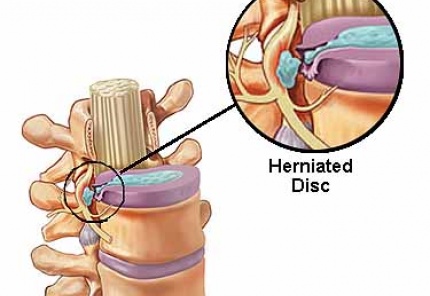Cervical disc herniation is a common cause of neck and upper body pain. A cervical herniated disc is diagnosed when the inner core of a disc in the neck herniates or leaks out of the disc, and presses on an adjacent nerve root.
Pain may exhibit dull or sharp in the neck, within the shoulder blades, and may radiate down into the arms, hands, and fingers. Some positions and movement can increase and aggravate pain. It normally happens in the 30-to-50-year-old age group.
If a cervical herniated disc can cause spinal cord compression, this is a much more serious condition and may need a more aggressive treatment plan. Spinal cord compression symptoms involve- stumbling gait, difficulty with fine motor skills in the hands and arms, and shock type feelings down the torso or into the legs.
Causes of Cervical Disc Herniation
Most herniations in the cervical region occur as a consequence of sudden stress, during in sudden flexion, extension, or twisting of the neck. Sometimes herniations occur gradually, over the weeks or months. However, some risk factors that can contribute to the chances of a disc herniation-
- As we get older, discs gradually dry out, affecting their strength and resiliency.
- History of extreme or minor trauma to the cervical spine.
- Shortage of regular exercise, not consuming a well-balanced diet, and tobacco use considerably contribute to poor disc health.
- Poor posture on the cervical spine.
Stages of a Cervical Herniated Disc
Symptoms of Cervical Disc Herniation
A herniated disc in the neck can cause a variety of symptoms in the neck, arm, hand, and fingers, as well as parts of the shoulder. The symptoms of a cervical herniated disc might include:
- Shock-like or burning pain.Dull or sharp pain in the neck or between the shoulder blades, which can intensify in certain positions or after certain movements.
- Pins-and-needles tingling.Pain that radiates down the arm to the hand or fingers (radiculopathy).
- Numbness in the shoulder or arm, which may or may not include tingling.
- Weakness, which could affect the shoulder, arm, and also hand strength.

The pain patterns and neurological deficits are largely determined by the location of the herniated disc. For example-
A C4-C5 (C5 nerve root)disc herniation at this level can cause shoulder pain and weakness in the deltoid muscle and does not usually cause numbness or tingling.
A C5-C6 (C6 nerve root) herniation can cause weakness in the biceps muscle and wrist extensor muscles. Numbness and tingling along with pain can radiate to the thumb side of the hand. This is the several common levels of a cervical disc herniation.

A C6-C7 (C7 nerve root) disc herniation can cause weakness in the triceps muscle. Numbness and tingling along with pain can transmit below the triceps and into the middle finger. This level is also the usual common areas for a cervical disc herniation.
A C7-T1 (C8 nerve root) disc herniation this level can cause weakness with the handgrip, along with numbness and tingling and pain that spreads below the arm to the little finger side of the hand.
Diagnosis of Cervical Disc Herniation
Proper treatment is always based on a specific diagnosis. The complete diagnostic process includes-
Your physician will talk about your symptoms, how severe they are, and what procedures you have previously undertaken. You will be thoroughly examined for limitations of movement, problems with balance, and pain. Through this exam, the physician will also look for impairment of reflexes in the extremities, muscle weakness, impairment of sensation or other manifestations of spinal cord damage.
Generally, physicians start with plain x-ray, which rules out other problems such as infections. CT scans and MRIs are further employed to give three-dimensional views of the lumbar spine and can help distinguish herniated discs.
Treatment of Cervical Disc Herniation
Nonsurgical Treatment Options
Most cases of cervical disc herniation do not require surgery. Often, within 4 to 6 weeks most patients find nonsurgical treatments relieve pain and symptoms. There are a number of non-surgical treatments that can help relieve symptoms. These include the following:
Pain medications such as a nonsteroidal anti-inflammatory drug to reduce swelling, the muscle relaxant to ease spasms, and/or a pain reliever.
Heat/cold therapy, especially during the first 24-48 hours.
Physical therapy may include cold and heat treatment, gentle massage, stretching, and neck bracing or traction to decrease pain and increase flexibility.

In conjunction with these treatments, to maintain a healthy posture, good body mechanics, and suitable exercises.
Be optimistic about your treatment plan and remember that less than 5% of neck problems require surgery.
Surgical Treatment Options
If non-operative measures do not work, surgery may be recommended. If the herniated disc is compressing the spinal cord (cervical myelopathy), surgery may be necessary. An anterior cervical discectomy is the usual common surgical method to manage injured cervical discs.

Sometimes it is required to access the herniated disc from behind by removing a portion of the lamina. The name of the procedure is laminotomy (posterior laminotomy). Favorably, each method can be done minimally invasive and tiny specialized instruments such as microscopes and endoscopes, and sometimes in an outpatient spine operation center.
Prevention of Cervical Disc Herniation
Aging is unavoidable, but lifestyle modifications can help prevent cervical disc disease. Practice good posture and body mechanics, manage healthy body weight, make regular exercise, and don’t smoke.

